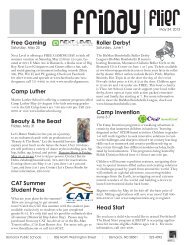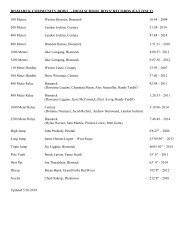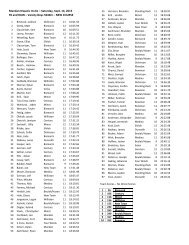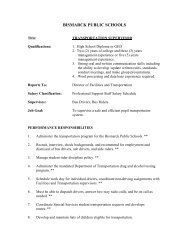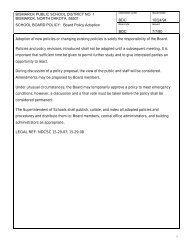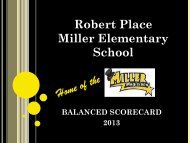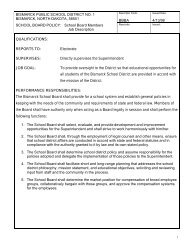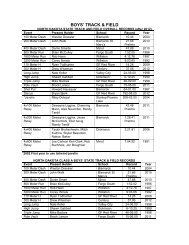Scott Foresman Reading Street - Bismarck Public Schools
Scott Foresman Reading Street - Bismarck Public Schools
Scott Foresman Reading Street - Bismarck Public Schools
Create successful ePaper yourself
Turn your PDF publications into a flip-book with our unique Google optimized e-Paper software.
Suggested levels for Guided <strong>Reading</strong>, DRA, <br />
Lexile, ® and <strong>Reading</strong> Recovery are provided<br />
in the Pearson <strong>Scott</strong> <strong>Foresman</strong> Leveling Guide.<br />
Genre<br />
Expository<br />
nonfiction<br />
Comprehension<br />
Skills and Strategy<br />
• Main Idea and<br />
Details<br />
• Generalize<br />
• Graphic Organizers<br />
Text Features<br />
• Heads<br />
• Captions<br />
• Time Line<br />
• Glossary<br />
<strong>Scott</strong> <strong>Foresman</strong> <strong>Reading</strong> <strong>Street</strong> 4.1.5<br />
ì
Reader Response<br />
1. Reread the section headings in this book. What<br />
is a main idea in the book? Make sure to give<br />
examples to support your answer.<br />
2. Choose three dates from the time line on<br />
page 7. Make a time line similar to the one<br />
below with the dates you have chosen. Tell what<br />
happened on each date.<br />
Date<br />
3. Look in the Glossary. On a separate piece of<br />
paper, write the word with the suffix –ive. Write<br />
the word with the suffix –ist. Use each word in a<br />
complete sentence.<br />
4. What can the time line on page 7 tell you about<br />
national parks?<br />
by Johanna Biviano<br />
Editorial Offices: Glenview, Illinois • Parsippany, New Jersey • New York, New York<br />
Sales Offices: Needham, Massachusetts • Duluth, Georgia • Glenview, Illinois<br />
Coppell, Texas • Ontario, California • Mesa, Arizona
Our National Parks<br />
America’s national parks have some of the most<br />
impressive plants, animals, and land in nature.<br />
Suppose you are flying in a plane over these parks.<br />
Look out the window. You can see great forests,<br />
crystal rivers, flocks of birds, and herds of animals.<br />
The National Park Service was established to<br />
preserve this wilderness.<br />
Wapati elks lie in the<br />
tall grass in Yellowstone<br />
National Park.<br />
Every effort has been made to secure permission and provide appropriate credit for<br />
photographic material. The publisher deeply regrets any omission and pledges to<br />
correct errors called to its attention in subsequent editions.<br />
Unless otherwise acknowledged, all photographs are the property of <strong>Scott</strong> <strong>Foresman</strong>,<br />
a division of Pearson Education.<br />
Photo locators denoted as follows: Top (T), Center (C), Bottom (B), Left (L), Right (R),<br />
Background (Bkgd)<br />
Opener: Getty Images; 1 Corbis; 4 Creatas; 5 Getty Images; 6 Getty Images; 8 Digital<br />
Vision; 9 Corbis, Peter Arnold; 10 Corbis/Richard T. Nowitz, Corbis/Dave G. Houser,<br />
Stock Imagery; 11 Photo Researchers; 12 Getty Images; 13 Corbis, Getty Images;<br />
14 Brand X Pictures, Getty Images; 15 Digital Stock, Getty Images<br />
ISBN: 0-328-13424-4<br />
Copyright © Pearson Education, Inc.<br />
All Rights Reserved. Printed in the United States of America. This publication is<br />
protected by Copyright, and permission should be obtained from the publisher<br />
prior to any prohibited reproduction, storage in a retrieval system, or transmission<br />
in any form by any means, electronic, mechanical, photocopying, recording, or<br />
likewise. For information regarding permission(s), write to: Permissions Department,<br />
<strong>Scott</strong> <strong>Foresman</strong>, 1900 East Lake Avenue, Glenview, Illinois 60025.<br />
2 3 4 5 6 7 8 9 10 V0G1 14 13 12 11 10 09 08 07 06 05<br />
3
George Catlin, a famous artist, traveled through<br />
America in 1832. He saw great valleys and rivers.<br />
He saw buffalo herds roaming the plains. He learned<br />
about Native American life and about all the different<br />
people he met.<br />
George Catlin worried that people coming<br />
to settle the wild lands would use it all up. He<br />
wondered how to preserve the land and the species,<br />
or kinds of plants and animals, on it. He hoped<br />
that people would want to protect nature.<br />
The government felt the same as George Catlin<br />
did. It wanted to make parks out of the natural<br />
wonders in America. Lawmakers decided to create<br />
a park where the Yellowstone River flowed, through<br />
parts of what we now call Montana, Wyoming,<br />
and Idaho. In 1872 Yellowstone became the first<br />
national park.<br />
Yellowstone National Park<br />
A herd of bison grazing in the<br />
Theodore Roosevelt National<br />
Park in North Dakota<br />
4<br />
5
Historical Sites<br />
The United States also wanted to preserve places<br />
that are important in our history. Some sites of<br />
prehistoric ruins became parks around 1900. Mesa<br />
Verde National Park in Colorado is filled with the<br />
ruins of cliff dwellings, or homes, of the ancient<br />
Pueblo people.<br />
Cliff dwellings of Mesa<br />
Verde in Colorado<br />
Some parks, such as the Grand Canyon in<br />
Arizona, were meant to be used for scientific<br />
learning. Scientists and other visitors can study the<br />
natural wonders of these parks.<br />
In the eastern United States, there were not<br />
many national parks. Then the National Park Service<br />
created monuments at famous historical places.<br />
These national monuments preserve birthplaces<br />
of presidents, and battlefields and cemeteries from<br />
American wars.<br />
National Parks<br />
1872 Yellowstone National Park<br />
(Montana, Wyoming, and Idaho)<br />
1890 Yosemite Valley National Park<br />
(California)<br />
1908 Grand Canyon National<br />
Monument (Arizona)<br />
1916 Abraham Lincoln Birthplace<br />
National Historic Site (Kentucky)<br />
1936 Colonial National Historical Park<br />
(Virginia)<br />
1980 Women’s Rights National<br />
Historical Park (New York)<br />
6<br />
Yosemite Valley<br />
National Park in<br />
California<br />
7
Landscapes and Wildlife<br />
Mount McKinley is in Denali National Park, in<br />
Alaska. Mount McKinley stands 20,320 feet above<br />
sea level. It is the tallest mountain in North America.<br />
Six million acres of land make up Denali National<br />
Park. Many different kinds of plants and animals live<br />
on its mountain slopes. The plants in Denali have<br />
to be tough. Most of the ground under the top layer<br />
of soil stay s frozen.<br />
The animals in Denali have to be strong too. Only<br />
a small number of Denali’s birds can stay through<br />
the harsh, long winters. Most of Denali’s birds<br />
migrate south for the winter. They then return for<br />
the short summer season. They depend on Denali’s<br />
lakes, rivers, streams, and ponds. Glaciers from ten<br />
thousand years ago made these bodies of water.<br />
Mount McKinley in Alaska<br />
Wildlife in Denali<br />
National Park<br />
Grizzly bear<br />
Caribou<br />
8<br />
9
Another Historical Park<br />
The Colonial National Historical Park in Virginia<br />
shows us how America looked to the first English<br />
settlers. Like Denali National Park, this park is full<br />
of impressive animals. Some of these animals are<br />
endangered. There are also acres of protected land.<br />
Jamestown’s “Old Towne” is located in the<br />
Colonial National Historical Park. Old Towne<br />
preserves the site of the first English settlement at<br />
Jamestown, founded in 1607.<br />
In Old Towne, guides wear clothes like those of<br />
the first settlers. Visitors can learn about the life of<br />
Pocahontas, a famous Powhatan woman. Pocahontas<br />
helped settlers and Native Americans communicate.<br />
Visitors can also see a statue of Captain John Smith,<br />
who led the settlers in building the Jamestown<br />
Settlement. You can relive history at the Colonial<br />
National Historical Park.<br />
You can visit the re-creation of the<br />
original Jamestown settlement.<br />
Guides dress in colonial<br />
costume at Old Towne.<br />
10<br />
11
Preserving Wildlife<br />
What does it mean to create a national park?<br />
When the United States chose the land for the<br />
first parks, there were no fences, no roads, no<br />
bathrooms, and no guides! Who would take care<br />
of the parks and make them easy to visit?<br />
The U.S. Army was in charge in the 1890s. They<br />
made roads and buildings. They guarded the parks<br />
from hunters and loggers. They allowed people to<br />
visit the parks to learn about the wildlife. In 1916 the<br />
National Park Service was formed to run the parks.<br />
Roads and buildings in the parks were improved in<br />
the 1930s, and new parks were made.<br />
Most national parks<br />
have park rangers<br />
to answer questions<br />
visitors might have.<br />
The Civilian<br />
Conservation Corps at<br />
work (below) and the<br />
corps’ badge (left)<br />
12<br />
13
As soon as the first national park was created,<br />
people began to argue about how to use the parks.<br />
Should we let naturalists study the animals and<br />
plants? Should we use the rivers to water the<br />
farms nearby? Should we dig for oil? Should<br />
builders use the wood from the forests?<br />
All of these questions now have answers. In<br />
national parks we preserve nature. We do not cut<br />
down the wood for lumber. We do not use the water<br />
for farming. All of the animals that live in the parks<br />
are kept safe from hunters. We protect the historical<br />
sites and the natural wonders of the wilderness, just<br />
as George Catlin hoped that we would!<br />
It is important to protect<br />
our natural wildlife.<br />
Pika<br />
Ibis<br />
Wolf<br />
14<br />
15
Glossary<br />
glaciers n. great<br />
masses of ice moving<br />
very slowly down a<br />
mountain, along a<br />
valley, or over a land<br />
area.<br />
impressive adj. able to<br />
have a strong effect on<br />
the mind or feelings;<br />
able to influence deeply.<br />
naturalists n. people<br />
who make a study of<br />
living things.<br />
preserve v. to keep<br />
from harm or change;<br />
keep safe; protect.<br />
slopes n. lines, surfaces,<br />
land, etc., that go up or<br />
down at an angle.<br />
species n. a set of<br />
related living things<br />
that all have certain<br />
characteristics.<br />
wilderness n. a wild<br />
uncultivated region with<br />
few or no people living<br />
in it.<br />
Reader Response<br />
1. Reread the section headings in this book. What<br />
is a main idea in the book? Make sure to give<br />
examples to support your answer.<br />
2. Choose three dates from the time line on<br />
page 7. Make a time line similar to the one<br />
below with the dates you have chosen. Tell what<br />
happened on each date.<br />
Date<br />
3. Look in the Glossary. On a separate piece of<br />
paper, write the word with the suffix –ive. Write<br />
the word with the suffix –ist. Use each word in a<br />
complete sentence.<br />
4. What can the time line on page 7 tell you about<br />
national parks?<br />
16



